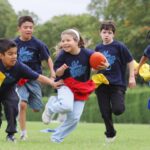Can Early Sport Specialization Lead to an Increase in Sports Injuries?
Adolescent sports injuries are on the rise and have actually been termed the “silent epidemic” in the field of sports medicine.
Historically, young kids participated in a variety of sports rotating through different sports as the seasons changed. Young boys might have rotated through football in the fall, basketball in the winter, and baseball in the spring. Young girls may have participated in volleyball in the fall, basketball in the winter, and tennis in the spring.
Participating in a variety of sports had definite health benefits for young athletes. Competing and training for different sports developed different muscle groups in their bodies. Muscles that were used predominantly during one sport would get a rest as the seasons changed. Soft tissues (muscles, tendons, ligaments) that were worn down during one season were allowed time to heal and recover as young athletes moved on to focus on a different set of muscles for their next sport.
Young athletes were also able to develop their motor skills in a variety of sports becoming well-rounded athletes. Athletes were able to develop both upper extremity overhand skills as well as skills that focused on the lower extremity (i.e., jumping, running, changing directions).
In the past, multi-sport athletes were the norm in junior high and high school sports and not the exception. Unfortunately, as the desire to develop elite competitive young athletes has risen in recent years, multi-sport athletes have become a thing of the past.
The culture of youth sports has changed dramatically. Young athletes have been pressured to specialize in one sport at younger and younger ages in order to compete and participate at even the high school level.
With the evolution of the youth sports culture also came the emergence of specialized club teams with the purpose of providing year-round training for young athletes. Parents pay high fees in order to have their sons and/or daughters compete on elite club teams, many with the hopes of securing college athletic scholarships for their children.
If year-round specialized club programs and high school sports do not provide enough physical training, parents can also hire personalized fitness trainers for their children. If fine tuning the muscles and cardiovascular systems are not enough, private coaches can be hired to further train and develop specific motor skills (pitching/hitting coaches for baseball and softball).
Today, it is not uncommon to see young athletes practicing two to three hours a day during the weekdays and then competing in multiple sports events on the weekends. And if competing on one team is not enough, athletes can sign up and compete on multiple teams in the same sport.
With this amount of focused training in young athletes, it is not at all surprising that overuse sports injuries are on the rise in adolescent athletes. Although early specialization may lead to a college scholarship, young athletes may be paying a price. Besides psychological burnout, young athletes can suffer from a number of overuse sports injuries including injuries to the muscles, tendons, ligaments, and bones.
Because the musculoskeletal system in young bodies has not matured, these structures may be subject to overuse sports injuries. Just as mature athletes can suffer from overuse injuries to muscles, tendons, ligaments, and bones, young athletes can suffer from the same injuries. However, they are more susceptible to these injuries because their tissues are not strong enough to handle the repetitive forces.
For example, bones in young athletes are not strong enough to handle the same amount of stress that an adult’s can. As athletes mature and develop, their bones become stronger (with the intake of calcium) and increase in density over time because of repetitive compressive loading (weight-bearing exercise).
Young bones are naturally weaker and are subject to injury including stress fractures. Also unique to young athletes are sports injuries to the ends of bones (at the growth plates). The growth plates at the end of each long bone are responsible for new bone growth. An injury to the growth plate of a long bone can permanently damage the bone’s ability to grow.
Overuse injuries are injuries to musculoskeletal tissue caused by repetitive loading. They include tendinitis, stress fractures, muscle injuries, and bursitis. Overuse sports injuries can range from mild to severe and include the following four classifications:
• Pain after the activity
• Pain during the activity that does not affect the activity
• Pain during the activity that affects that activity
• Constant pain even at rest
For mild pain, sports injury treatment using the P.R.I.C.E. principle – Protection, Rest, Icing, Compression, Elevation – can be applied. However, athletes with injuries that begin to affect their performance need to be referred to a sports medicine professional for diagnosis and treatment.
The American Academy of Pediatrics released a set of guidelines to help prevent overuse injuries in young athletes. The guidelines include:
• Limiting each sport activity to five days a week (including competitive play, sports specific training, and scrimmage)
• Resting one day a week from all physical activity
• Taking two to three months off of sports per year
• Increasing weekly training time, number of repetitions, and total distance by no more than ten percent each week
Additional recommendations to reduce overuse injuries in young athletes include:
• Referring any athlete complaining of pain, tenderness, or limitation of movement to a qualified sports medicine professional
• Training the athlete on a variety of surfaces (if applicable)
• Tailoring the program to the physical maturation and skill level of the athlete
• Carefully monitoring the frequency, duration, and intensity of the training and/or competition
References
Armstrong, C. (December 1, 2007). American Academy of Pediatrics Releases Recommendations on Overuse Injuries and Overtraining in Child Athletes. American Family Physician. http://www.aafp.org.
Brukner, P., & Khan, K. (2001). Clinical Sports Medicine. (2nd Ed.). McGraw-Hill: Australia.





